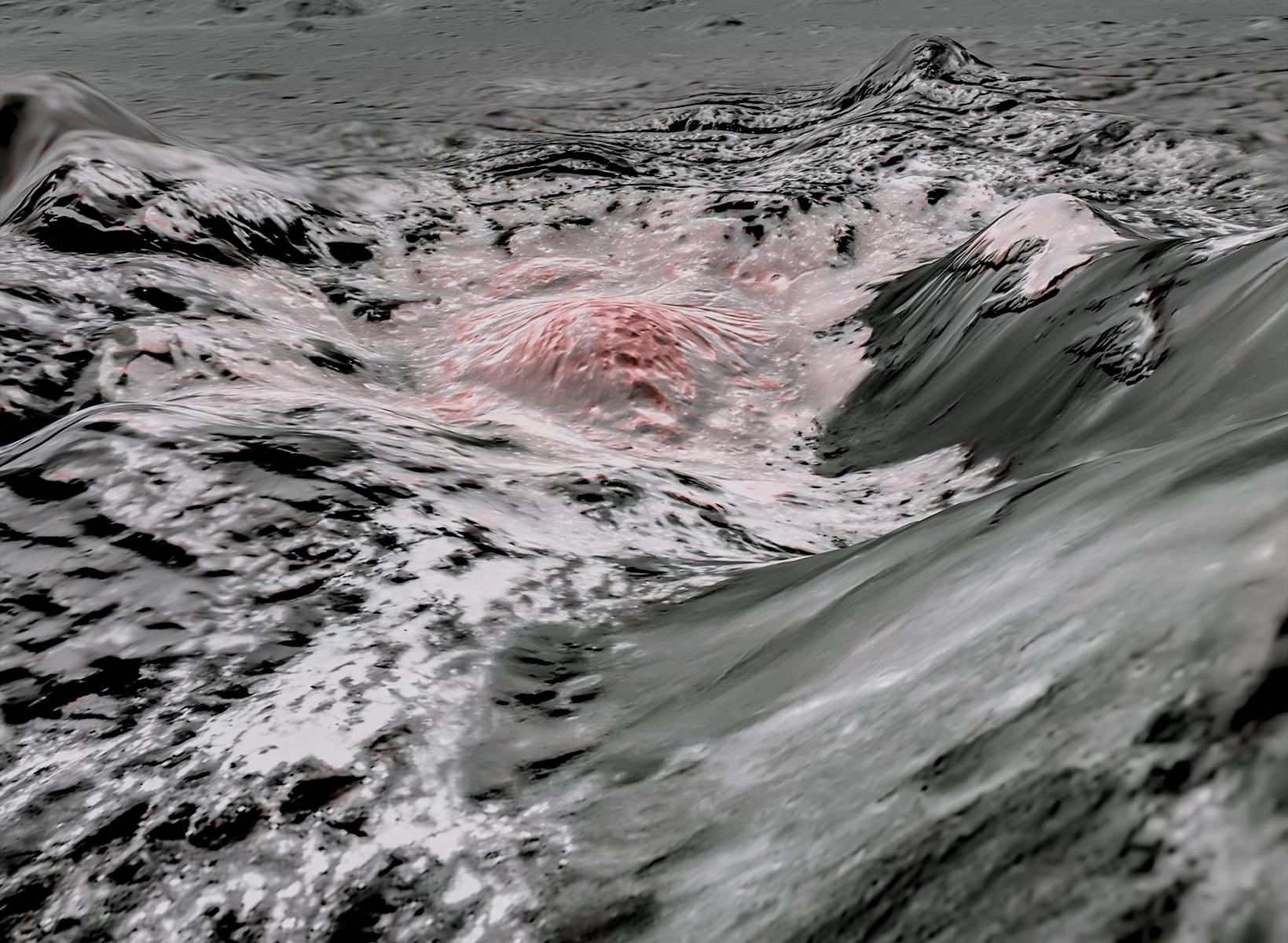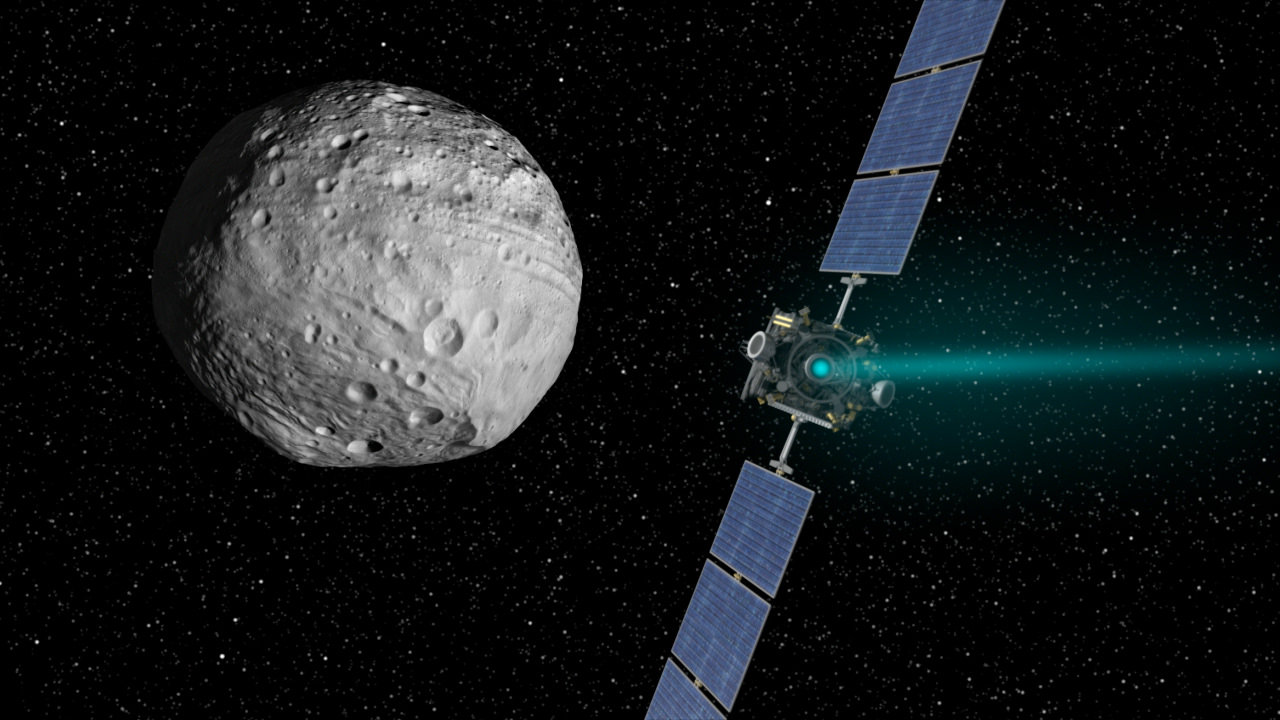A new and thorough analysis of high-resolution images and data from NASA’s Dawn mission have now provided fresh insights into the dwarf planet Ceres, with intriguing evidence that Ceres has a global subsurface salty ocean, and has been geologically active in the recent past.
Continue reading “It’s Starting to Look Like Ceres is an Ocean World, Too”Ceres is a Strange Place, Including a Volcanic Peak 4,000 Meters High Made From Bubbling Salt Water, Mud and Rock
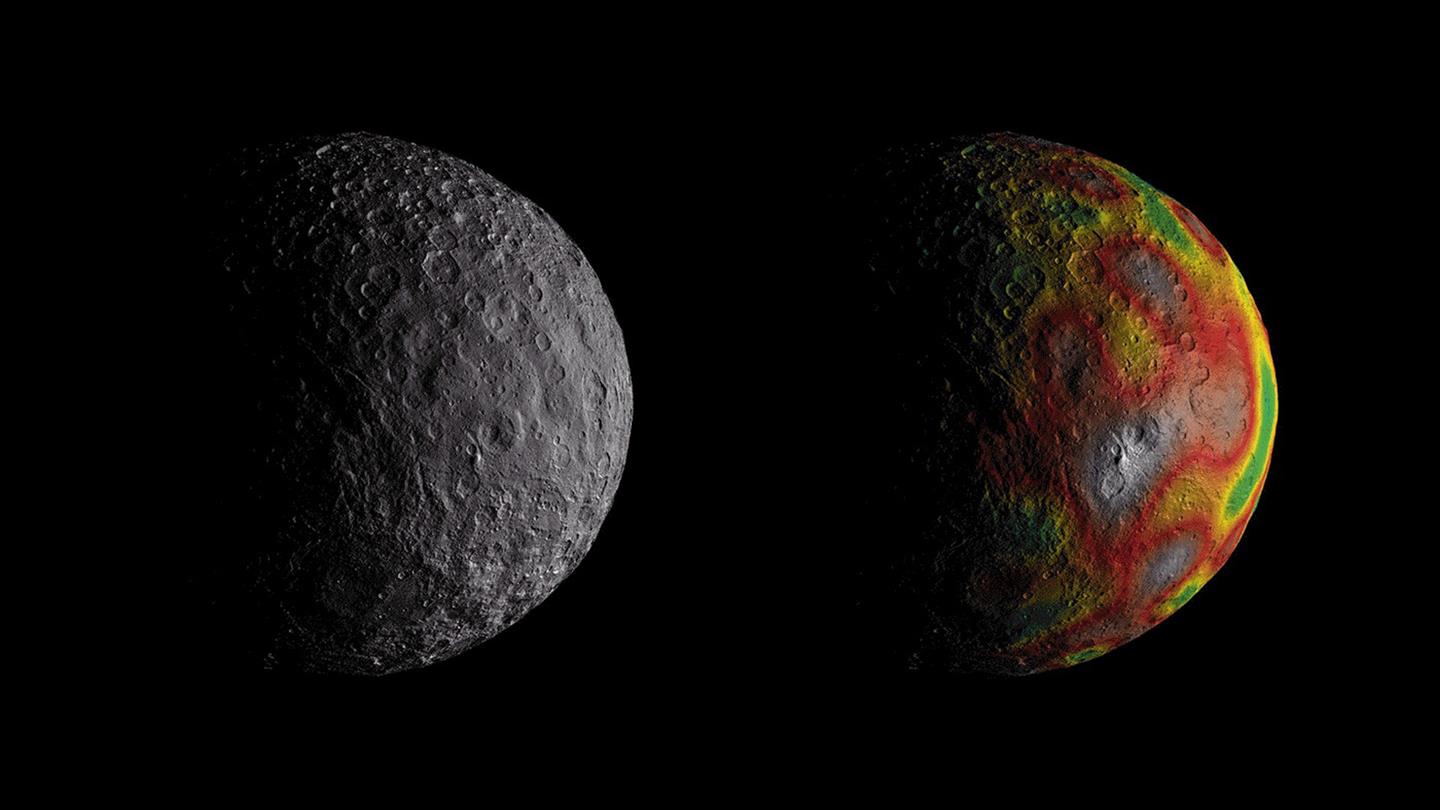
Ceres, at almost 1,000 km (620 miles) in diameter, is the largest body in the asteroid belt. Between 2015 and 2018, NASA’s ion-powered Dawn spacecraft visited the dwarf planet, looking for clues to help us understand how our Solar System formed. Ceres is the first dwarf planet ever visited by a spacecraft.
Now that scientists have worked with the data from Dawn, we’re starting to see just how unusual Ceres is. One of the most shocking of Dawn’s findings is the volcano Ahuna Mons, a feature that seems out of place on this tiny world. Now scientists from the German Aerospace Center (DLR) have figured out how this strange feature formed on this intriguing little planet.
Continue reading “Ceres is a Strange Place, Including a Volcanic Peak 4,000 Meters High Made From Bubbling Salt Water, Mud and Rock”Ceres Rolled Over at Some Point in the Past
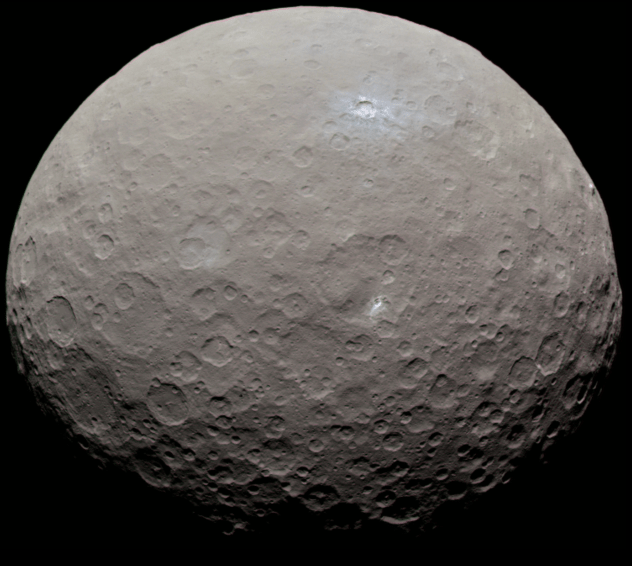
In 2007, the Dawn mission launched from Earth and began making its way towards two historic rendezvous in the Main Asteroid Belt. The purpose of this mission was to learn more about the history of the early Solar System by studying the two largest protoplanets in the Main Belt – Ceres and Vesta – which have remained intact since their formation.
In 2015, the Dawn mission arrived in orbit around Ceres and began sending back data that has shed light on the protoplanet’s surface, composition and interior structure. Based on mission data, Pasquale Tricarico – the senior scientist at the Planetary Science Institute (PSI) – has also determined that the Ceres also experienced an indirect polar reorientation in the past, where its pole rolled approximately 36° off-axis.
Continue reading “Ceres Rolled Over at Some Point in the Past”
Ice Volcanoes on Ceres are Still Actively Blasting out Material
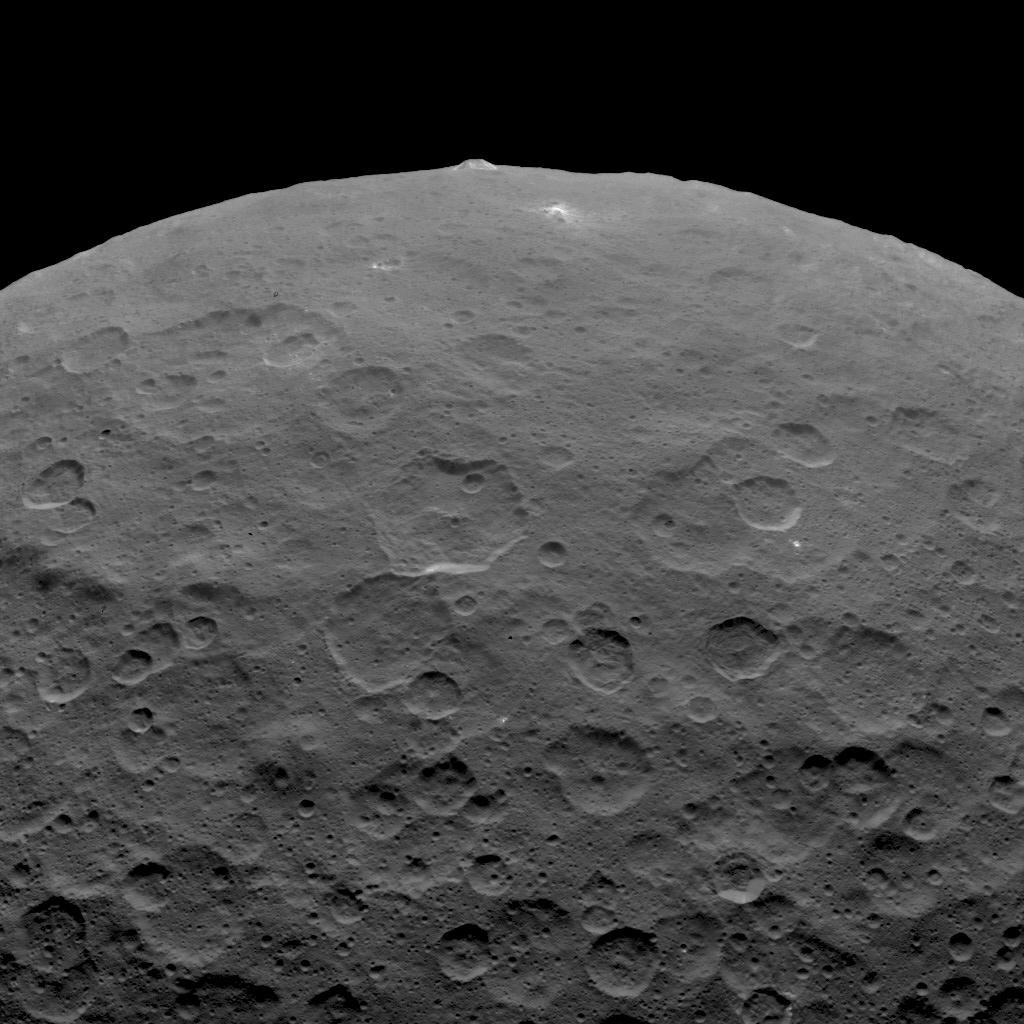
In science, one discovery often leads to more questions and mysteries. That’s certainly true of the ice volcanoes on the dwarf planet Ceres. When the Dawn spacecraft discovered the massive cryovolcano called Ahuna Mons on the surface of Ceres, it led to more questions: How cryovolcanically active is Ceres? And, why do we only see one?
Continue reading “Ice Volcanoes on Ceres are Still Actively Blasting out Material”
Ceres Has Even More Organic Molecules on it Than Previously Thought

In March of 2015, NASA’s Dawn mission became the first spacecraft to visit the protoplanet Ceres, the largest body in the Main Asteroid Belt. It was also the first spacecraft to visit a dwarf planet, having arrived a few months before the New Horizons mission made its historic flyby of Pluto. Since that time, Dawn has revealed much about Ceres, which in turn is helping scientists to understand the early history of the Solar System.
Last year, scientists with NASA’s Dawn mission made a startling discovery when they detected complex chains of carbon molecules – organic material essential for life – in patches on the surface of Ceres. And now, thanks to a new study conducted by a team of researchers from Brown University (with the support of NASA), it appears that these patches contain more organic material than previously thought.
The new findings were recently published in the scientific journal Geophysical Research Letters under the title “New Constraints on the Abundance and Composition of Organic Matter on Ceres“. The study was led by Hannah Kaplan, a postdoctoral researcher at Brown University, with the assistance of Ralph E. Milliken and Conel M. O’D. Alexander – an assistant professor at Brown University and a researcher from the Carnegie Institution of Washington, respectively.
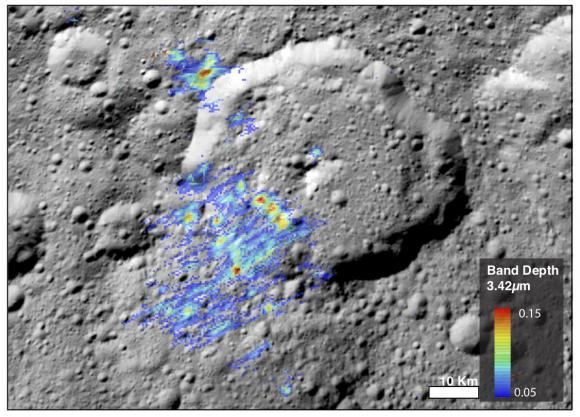
The organic materials in question are known as “aliphatics”, a type of compound where carbon atoms form open chains that are commonly bound with oxygen, nitrogen, sulfur and chlorine. To be fair, the presence of organic material on Ceres does not mean that the body supports life since such molecules can arise from non-biological processes.
Aliphatics have also been detected on other planets in the form of methane (on Mars and especially on Saturn’s largest moon, Titan). Nevertheless, such molecules remains an essential building block for life and their presence at Ceres raises the question of how they got there. As such, scientists are interested in how it and other life-essential elements (like water) has been distributed throughout the Solar System.
Since Ceres is abundant in both organic molecules and water, it raises some intriguing possibilities about the protoplanet. The results of this study and the methods they used could also provide a template for interpreting data for future missions. As Dr. Kaplan – who led the research while completing her PhD at Brown – explained in a recent Brown University press release:
“What this paper shows is that you can get really different results depending upon the type of organic material you use to compare with and interpret the Ceres data. That’s important not only for Ceres, but also for missions that will soon explore asteroids that may also contain organic material.”
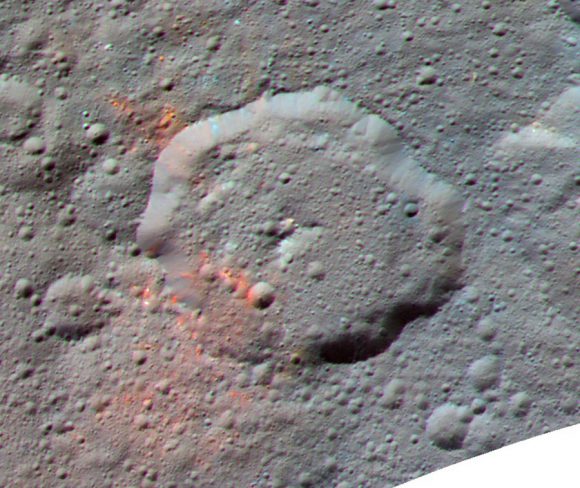
The original discovery of organics on Ceres took place in 2017 when an international team of scientists analyzed data from the Dawn mission’s Visible and Infrared Mapping Spectrometer (VIRMS). The data provided by this instrument indicated the presence of these hydrocarbons in a 1000 km² region around of the Ernutet crater, which is located in the northern hemisphere of Ceres and measures about 52 km (32 mi) in diameter.
To get an idea of how abundant the organic compounds were, the original research team compared the VIRMS data to spectra obtained in a laboratory from Earth rocks with traces of organic material. From this, they concluded that between 6 and 10% of the spectral signature detected on Ceres could be explained by organic matter.
They also hypothesized that the molecules were endogenous in origin, meaning that they originated from inside the protoplanet. This was consistent with previous surveys that showed signs of hydorthermal activity on Ceres, as well others that have detected ammonia-bearing hydrated minerals, water ice, carbonates, and salts – all of which suggested that Ceres had an interior environment that can support prebiotic chemistry.
But for the sake of their study, Kaplan and her colleagues re-examined the data using a different standard. Instead of relying on Earth rocks for comparison, they decided to examine an extraterrestrial source. In the past, some meteorites – such as carbonaceous chondrites – have been shown to contain organic material that is slightly different than what we are familiar with here on Earth.
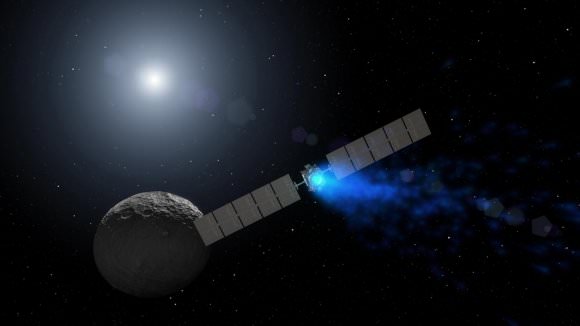
After re-examining the spectral data using this standard, Kaplan and her team determined that the organics found on Ceres were distinct from their terrestrial counterparts. As Kaplan explained:
“What we find is that if we model the Ceres data using extraterrestrial organics, which may be a more appropriate analog than those found on Earth, then we need a lot more organic matter on Ceres to explain the strength of the spectral absorption that we see there. We estimate that as much as 40 to 50 percent of the spectral signal we see on Ceres is explained by organics. That’s a huge difference compared to the six to 10 percent previously reported based on terrestrial organic compounds.”
If the concentrations of organic material are indeed that high, then it raises new questions about where it came from. Whereas the original discovery team claimed it was endogenous in origin, this new study suggests that it was likely delivered by an organic-rich comet or asteroid. On the one hand, the high concentrations on the surface of Ceres are more consistent with a comet impact.
This is due to the fact that comets are known to have significantly higher internal abundances of organics compared with primitive asteroids, similar to the 40% to 50% figure this study suggests for these locations on Ceres. However, much of those organics would have been destroyed due to the heat of the impact, which leaves the question of how they got there something of a mystery.
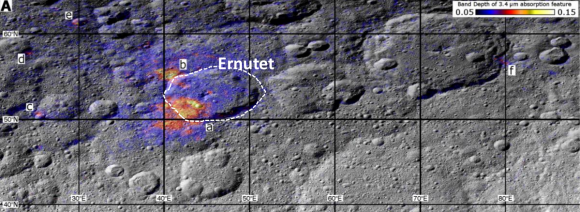
If they did arise endogenously, then there is the question of how such high concentrations emerged in the northern hemisphere. As Ralph Milliken explained:
“If the organics are made on Ceres, then you likely still need a mechanism to concentrate it in these specific locations or at least to preserve it in these spots. It’s not clear what that mechanism might be. Ceres is clearly a fascinating object, and understanding the story and origin of organics in these spots and elsewhere on Ceres will likely require future missions that can analyze or return samples.”
Given that the Main Asteroid Belt is composed of material left over from the formation of the Solar System, determining where these organics came from is expected to shed light on how organic molecules were distributed throughout the Solar System early in its history. In the meantime, the researchers hope that this study will inform upcoming sample missions to near-Earth asteroids (NEAs), which are also thought to host water-bearing minerals and organic compounds.
These include the Japanese spacecraft Hayabusa2, which is expected to arrive at the asteroid Ryugu in several weeks’ time, and NASA’s OSIRIS-REx mission – which is due to reach the asteroid Bennu in August. Dr. Kaplan is currently a science team member with the OSIRIS-REx mission and hopes that the Dawn study she led will help the OSIRIS-REx‘s mission characterize Bennu’s environment.
“I think the work that went into this study, which included new laboratory measurements of important components of primitive meteorites, can provide a framework of how to better interpret data of asteroids and make links between spacecraft observations and samples in our meteorite collection,” she said. “As a new member to the OSIRIS-REx team, I’m particularly interested in how this might apply to our mission.”
The New Horizons mission is also expected to rendezvous with the Kuiper Belt Object (KBO) 2014 MU69 on January 1st, 2019. Between these and other studies of “ancient objects” in our Solar System – not to mention interstellar asteroids that are being detected for the first time – the history of the Solar System (and the emergence of life itself) is slowly becoming more clear.
Further Reading: Brown University, Geophysical Research Letters
Dawn Probe Finds Evidence of Subsurface Ice on Vesta
In 2011, NASA’s Dawn spacecraft established orbit around the large asteroid (aka. planetoid) known as Vesta. Over the course of the next 14 months, the probe conducted detailed studies of Vesta’s surface with its suite of scientific instruments. These findings revealed much about the planetoid’s history, its surface features, and its structure – which is believed to be differentiated, like the rocky planets.
In addition, the probe collected vital information on Vesta’s ice content. After spending the past three years sifting through the probe’s data, a team of scientists has produced a new study that indicates the possibility of subsurface ice. These findings could have implications when it comes to our understanding of how Solar bodies formed and how water was historically transported throughout the Solar System.
Their study, titled “Orbital Bistatic Radar Observations of Asteroid Vesta by the Dawn Mission“, was recently published in the scientific journal Nature Communications. Led by Elizabeth Palmer, a graduate student from Western Michigan University, the team relied on data obtained by the communications antenna aboard the Dawn spacecraft to conduct the first orbital bistatic radar (BSR) observation of Vesta.
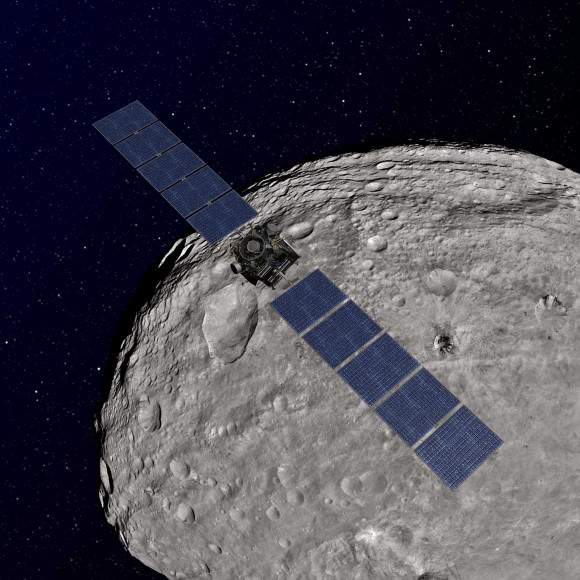
This antenna – the High-Gain telecommunications Antenna (HGA) – transmitted X-band radio waves during its orbit of Vesta to the Deep Space Network (DSN) antenna on Earth. During the majority of the mission, Dawn’s orbit was designed to ensure that the HGA was in the line of sight with ground stations on Earth. However, during occultations – when the probe passed behind Vesta for 5 to 33 minutes at a time – the probe was out of this line of sight.
Nevertheless, the antenna was continuously transmitting telemetry data, which caused the HGA-transmitted radar waves to be reflected off of Vesta’s surface. This technique, known as bistatic radar (BSR) observations has been used in the past to study the surfaces of terrestrial bodies like Mercury, Venus, the Moon, Mars, Saturn’s moon Titan, and the comet 67P/CG.
But as Palmer explained, using this technique to study a body like Vesta was a first for astronomers:
“This is the first time that a bistatic radar experiment was conducted in orbit around a small body, so this brought several unique challenges compared to the same experiment being done at large bodies like the Moon or Mars. For example, because the gravity field around Vesta is much weaker than Mars, the Dawn spacecraft does not have to orbit at a very high speed to maintain its distance from the surface. The orbital speed of the spacecraft becomes important, though, because the faster the orbit, the more the frequency of the ‘surface echo’ gets changed (Doppler shifted) compared to the frequency of the ‘direct signal’ (which is the unimpeded radio signal that travels directly from Dawn’s HGA to Earth’s Deep Space Network antennas without grazing Vesta’s surface). Researchers can tell the difference between a ‘surface echo’ and the ‘direct signal’ by their difference in frequency—so with Dawn’s slower orbital speed around Vesta, this frequency difference was very small, and required more time for us to process the BSR data and isolate the ‘surface echoes’ to measure their strength.”
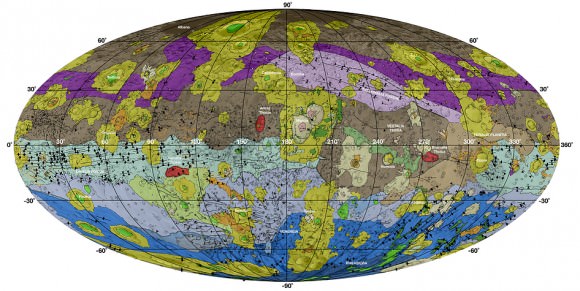
By studying the reflected BSR waves, Palmer and her team were able to gain valuable information from Vesta’s surface. From this, they observed significant differences in surface radar reflectivity. But unlike the Moon, these variations in surface roughness could not be explained by cratering alone and was likely due to the existence of ground-ice. As Palmer explained:
“We found that this was the result of differences in the roughness of the surface at the scale of a few inches. Stronger surface echoes indicate smoother surfaces, while weaker surface echoes have bounced off of rougher surfaces. When we compared our surface roughness map of Vesta with a map of subsurface hydrogen concentrations—which was measured by Dawn scientists using the Gamma Ray and Neutron Detector (GRaND) on the spacecraft—we found that extensive smoother areas overlapped areas that also had heightened hydrogen concentrations!”
In the end, Palmer and her colleagues concluded that the presence of buried ice (past and/or present) on Vesta was responsible for parts of the surface being smoother than others. Basically, whenever an impact happened on the surface, it transferred a great deal of energy to the subsurface. If buried ice was present there, it would be melted by the impact event, flow to the surface along impact-generated fractures, and then freeze in place.
Much in the same way that moon’s like Europa, Ganymede and Titania experience surface renewal because of the way cryovolcanism causes liquid water to reach the surface (where it refreezes), the presence of subsurface ice would cause parts of Vesta’ surface to be smoothed out over time. This would ultimately lead to the kinds of uneven terrain that Palmer and her colleagues witnessed.
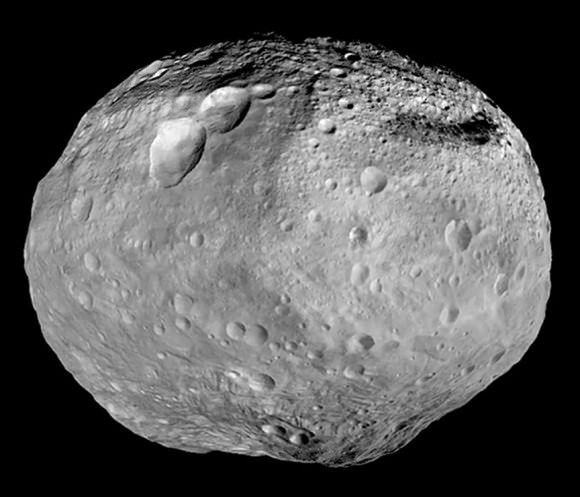
This theory is supported by the large concentrations of hydrogen that were detected over smoother terrains that measure hundreds of square kilometers. It is also consistent with geomorphological evidence obtained from the Dawn Framing Camera images, which showed signs of of transient water flow over Vesta’s surface. This study also contradicted some previously-held assumptions about Vesta.
As Palmer noted, this could also have implications as far as our understanding of the history and evolution of the Solar System is concerned:
“Asteroid Vesta was expected to have depleted any water content long ago through global melting, differentiation, and extensive regolith gardening by impacts from smaller bodies. However, our findings support the idea that buried ice may have existed on Vesta, which is an exciting prospect since Vesta is a protoplanet that represents an early stage in the formation of a planet. The more we learn about where water-ice exists throughout the Solar System, the better we will understand how water was delivered to Earth, and how much was intrinsic to Earth’s interior during the early stages of its formation.”
This work was sponsored by NASA’s Planetary Geology and Geophysics program, a JPL-based effort that focuses on fostering the research of terrestrial-like planets and major satellites in the Solar System. The work was also conducted with the assistance of the USC’s Viterbi School of Engineering as part of an ongoing effort to improve radar and microwave imaging to locate subsurface sources of water on planets and other bodies.
Further Reading: USC, Nature Communications
Ceres Prank Lands Bart Simpson In Detention For Eternity
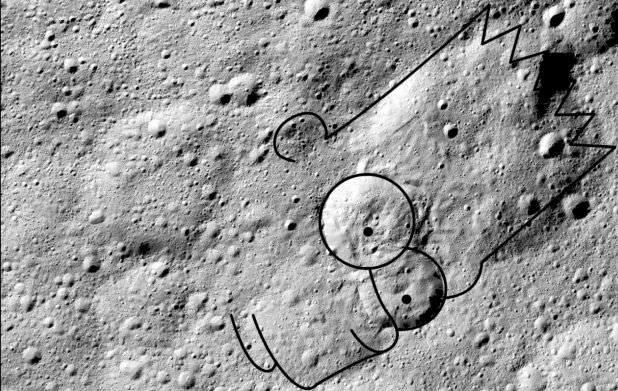
Human-kind has a long history of looking up at the stars and seeing figures and faces. In fact, there’s a word for recognizing faces in natural objects: pareidolia. But this must be the first time someone has recognized Bart Simpson’s face on an object in space.
Researchers studying landslides on the dwarf planet Ceres noticed a pattern that resembles the cartoon character. The researchers, from the Georgia Institute of Technology, are studying massive landslides that occur on the surface of the icy dwarf. Their findings are reinforcing the idea that Ceres has significant quantities of frozen water.
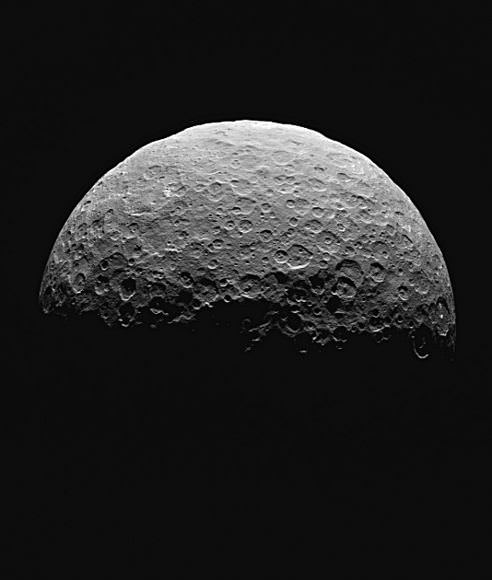
In a new paper in the journal Nature Geoscience, the team of scientists, led by Georgia Tech Assistant Professor and Dawn Science Team Associate Britney Schmidt, examined the surface of Ceres looking for morphologies that resemble landslides here on Earth.
Research shows us that Ceres probably has a subsurface shell that is rich with water-ice. That shell is covered by a layer of silicates. Close examination of the type, and distribution, of landslides at different latitudes adds more evidence to the sub-surface ice theory.
Ceres is pretty big. At 945 km in diameter, it’s the largest object in the asteroid belt between Mars and Jupiter. It’s big enough to be rounded by its own gravity, and it actually comprises about one third of the mass of the entire asteroid belt.
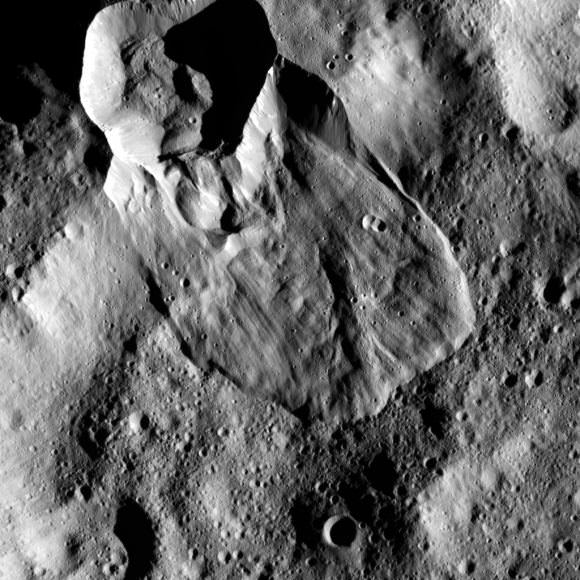
The team used observations from the Dawn Framing Camera to identify three types of landslides on Ceres’ surface:
- Type 1 are large, rounded features similar to glacier features in the Earth’s Arctic region. These are found mostly at high latitudes on Ceres, which is where most of the ice probably is.
- Type 2 are the most common. They are thinner and longer than Type 1, and look like terrestrial avalanche deposits. They’re found mostly at mid-latitudes on Ceres. The researchers behind the study thought one of them looked like Bart Simpson’s face.
- Type 3 occur mostly at low latitudes near Ceres’ equator. These are always found coming from large impact craters, and probably formed when impacts melted the sub-surface ice.
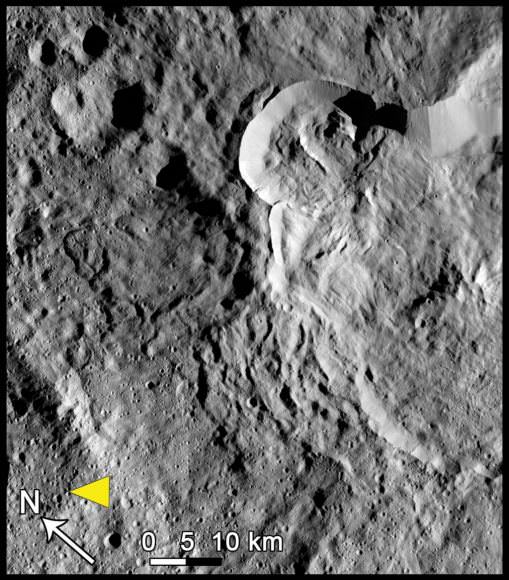
The authors of the study say that finding larger landslides further away from the equator is significant, because that’s where most of the ice is.
“Landslides cover more area in the poles than at the equator, but most surface processes generally don’t care about latitude,” said Schmidt, a faculty member in the School of Earth and Atmospheric Sciences. “That’s one reason why we think it’s ice affecting the flow processes. There’s no other good way to explain why the poles have huge, thick landslides; mid-latitudes have a mixture of sheeted and thick landslides; and low latitudes have just a few.”
Key to understanding these results is the fact that these types of processes have only been observed before on Earth and Mars. Earth, obviously, has water and ice in great abundance, and Mars has large quantities of sub-surface ice as well. “It’s just kind of fun that we see features on this small planet that remind us of those on the big planets, like Earth and Mars,” Schmidt said. “It seems more and more that Ceres is our innermost icy world.”
“These landslides offer us the opportunity to understand what’s happening in the upper few kilometers of Ceres,” said Georgia Tech Ph.D. student Heather Chilton, a co-author on the paper. “That’s a sweet spot between information about the upper meter or so provided by the GRaND (Gamma Ray and Neutron Detector) and VIR (Visible and Infrared Spectrometer) instrument data, and the tens of kilometers-deep structure elucidated by crater studies.”
It’s not just the presence of these landslides, but the frequency of them, that upholds the icy-mantle idea on Ceres. The study showed that 20% to 30% of craters on Ceres larger than 10 km have some type of landslide. The researchers say that upper layers of Ceres’ could be up to 50% ice by volume.
Confirmed: Ceres Has a Transient Atmosphere

Sometimes they see it, sometimes they don’t. That’s why scientists have never been completely sure if Ceres has an atmosphere or not. But now data from the Dawn spacecraft — in orbit of Ceres — confirms the dwarf planet really does have a very weak atmosphere, but it comes and goes.
The on-again-off-again nature of Ceres’ atmosphere appears to be linked to solar activity. When energetic particles from the Sun hit exposed ice within the craters on Ceres, the ice can sublimate and create an “exosphere” that lasts for a week or so.
Michaela Villarreal from UCLA, lead author of the new study, and her team wrote in their paper that the “atmosphere appeared shortly after the passage of a large enhancement in the local flux of high-energy solar protons,” and explained that when energetic particles from the Sun hit exposed ice and ice near the surface of the dwarf planet, it transfers energy to the water molecules as they collide. This frees the water molecules from the ground, allowing them to escape and create a tenuous atmosphere.

A process like this could also be taking place on the Moon, and is likely similar to the process similar to what takes place on comets.
“Our results also have implications for other airless, water-rich bodies of the solar system, including the polar regions of the moon and some asteroids,” said Chris Russell, principal investigator of the Dawn mission, also at UCLA. “Atmospheric releases might be expected from their surfaces, too, when solar activity erupts.”
There have been hints of an atmosphere at Ceres since the early 1990’s. In 1991, the International Ultraviolet Explorer satellite detected hydroxyl emission from Ceres, but not in 1990. Then, in 2007, the European Southern Observatory’s Very Large Telescope searched for a hydroxide emission, but came up empty. The European Space Agency’s Herschel Space Observatory detected water vapor as a possible weak atmosphere, on three occasions, but did not on a fourth attempt.

The Dawn spacecraft itself saw evidence of a transient atmosphere when it arrived at Ceres in March 2015, with data from its Gamma Ray and Neutron Detector instrument. It also has found ample evidence for water in the form of ice, found just underground at higher latitudes, where temperatures are lower. Ice has been detected directly at the small bright crater called Oxo and in at least one of the craters that are persistently in shadow in the northern hemisphere. Other research has suggested that persistently shadowed craters are likely to harbor ice. Additionally, the shapes of craters and other features are consistent with significant water-ice content in the crust.
The team’s research shows the atmosphere doesn’t necessarily show up when Ceres is close to the Sun or when sunlight hits the ice directly, but from energetic particles released by the Sun when its activity level is high. For example, the best detections of Ceres’ atmosphere did not occur at its closest approach to the Sun.
Also, the times where no atmosphere was detected coincided with lower solar activity, so the researchers say this suggests that solar activity, rather than Ceres’ proximity to the Sun, is a more important factor in generating an exosphere.
Ceres actually is now getting closer to the Sun. However, since the Sun appears to be in a very quiet period, Villarreal, Russell and team predict an atmosphere won’t show up, that the dwarf planet will have little to no atmosphere for some time. However, they said both Dawn and other observatories should keep an eye on what’s happening at Ceres.
Paper: The Dependence of the Cerean Exosphere on Solar Energetic Particle Events
Brightest ‘Spot’ on Ceres is Likely a Cryovolcano
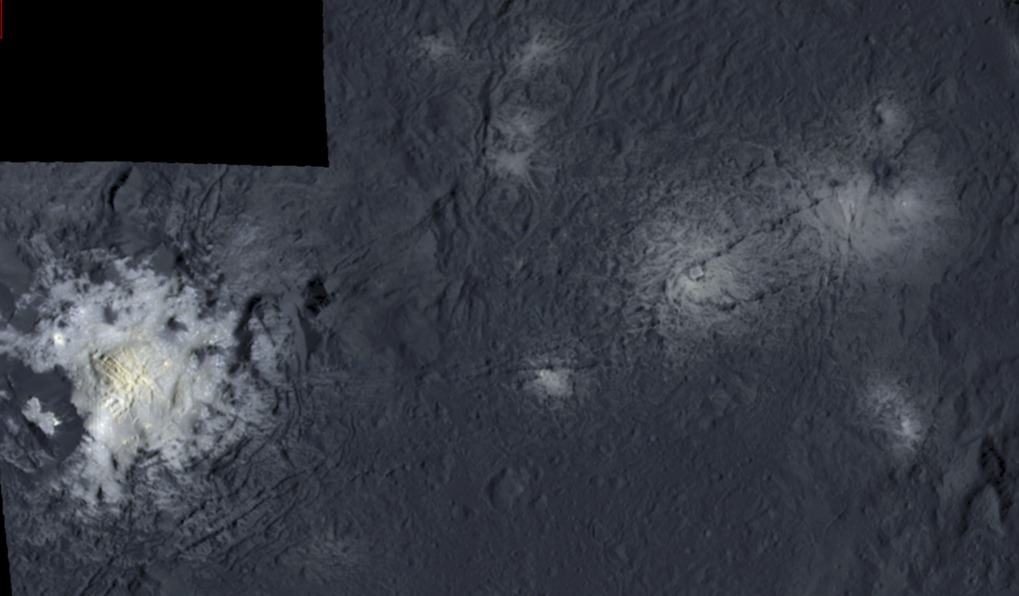
The bright regions on the dwarf planet Ceres have been some of the most talked about features in planetary science in recent years. While data from the Dawn spacecraft has shown these bright areas are salt deposits (alas, not lights of an alien city), the question remained of how these salts reached the surface.
Researchers with the Dawn mission say they have now thoroughly investigated the complex geological structures in Occator crater, the region with the brightest regions on Ceres. The scientists conclude that a bright dome-like feature called Cerealia Facula is the remnant of a cryovolcano — an ice volcano — that repeatedly and relatively recently spewed salty ice from within Ceres up to the surface.
“The age and appearance of the material surrounding the bright dome indicate that Cerealia Facula was formed by a recurring, eruptive process, which also hurled material into more outward regions of the central pit,” said Andreas Nathues, a Dawn scientist from the Max Planck Institute for Solar System Research. “A single eruptive event is rather unlikely.”
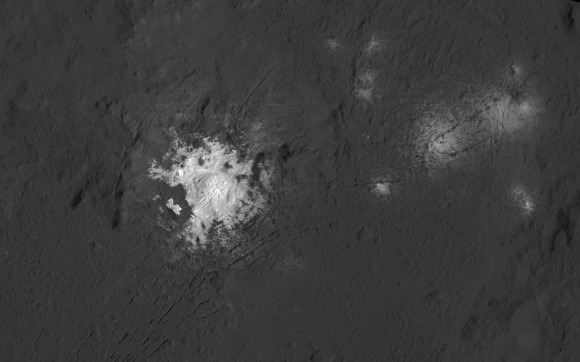
Occator crater located in the northern hemisphere of Ceres measures 92 kilometers (57 miles) in diameter. In its center is a pit with a diameter of about 11 kilometers (7 miles). On some parts of its edges, jagged mountains and steep slopes rise up to 750 meters (820 yards) high. Within the pit a bright dome formed. It has a diameter of 3 km (1.8 miles), is 400 meters (437 yards) high, with prominent fractures.
In analyzing images from Dawn’s Framing Camera, Nathues and his team deduced that the central pit is a remnant of a former central mountain, formed from the impact that created Occator Crater about 34 million years ago. But with a method for estimating the age of a planet’s surface – called crater counting — the science team could determine the dome of bright material is only about four million years old.
This suggests, the team said, that Occator crater has been the scene of eruptive outbursts of subsurface brine over a long period and until almost recently.
Jupiter’s moons Callisto and Ganymede show similar types of domes, and researchers interpret them as signs of cryovolcanism. While Ceres is too far from the Sun to be warm enough for regular volcanic activity, it very likely has harbored cryovolcanic activity, and it may even be active today.
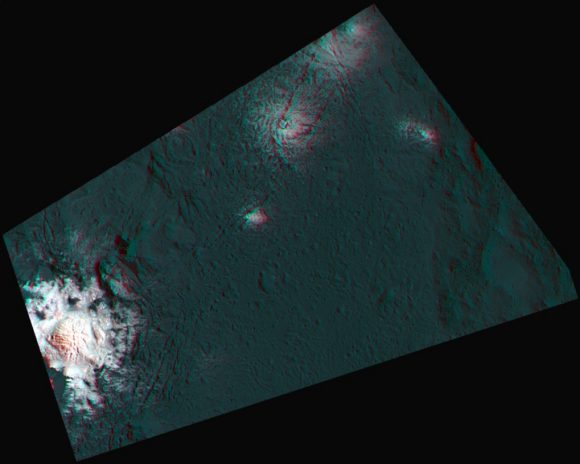
This 3d-anaglyph for the first time shows a part of Occator crater in a combination of anaglyphe and false-color image. Credit: NASA/JPL-Caltech/UCLA/MPS/DLR/IDA
Images from the Hubble Space Telescope taken more than a decade ago hinted at the bright spots in Occator Crater, but as the Dawn spacecraft approached Ceres in 2015, new images showed the bright areas almost shining like “cosmic beacons, like interplanetary lighthouses drawing us forth,” as described by Marc Rayman, the chief engineer and mission director for Dawn, in an interview with me last year.
Dawn scientist had previously determined the bright areas were salts left over from subsurface briny water that had made its way to the surface, and in the vacuum of space, the water sublimated away, leaving behind the dissolved salts. These salts were determined to be sodium carbonate and ammonium chloride.
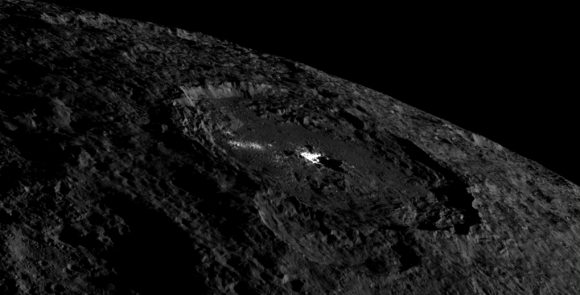
But don’t call these bright areas “spots,” said Rayman. “Some of these bright areas are miles across,” he said, “and just as if you were standing on salt flats on Earth that were several thousand acres, you wouldn’t say, ‘I’m standing on a spot.’ You are standing on a big area. But just to see the distribution of this material in the Dawn images shows there is something complex going on there.”
It is currently unknown if the region in Occator Crater is active, but there are hints it is, at least at a low level.
In 2014 the Herschel spacecraft detected water vapor above Occator, and images from Dawn’s cameras of the crater show a ‘haze’ when imaged at certain angles, and this has been explained as the sublimation of water.
Dawn scientists are also studying the large volcanic feature on Ceres, Ahuna Mons, to determine if it could be a cryovolcano, and will continue to study other bright areas on Ceres, as well.
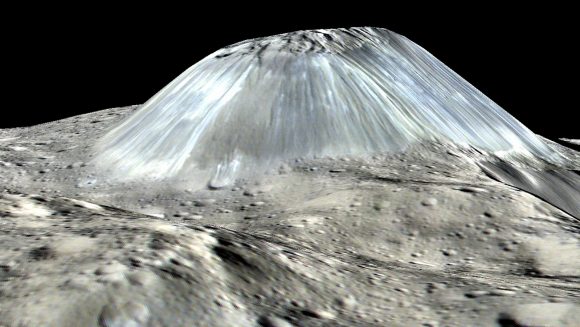
Further Reading: Max Planck Institute for Solar System Research
Ice, Ice Everywhere, says New Study on Ceres
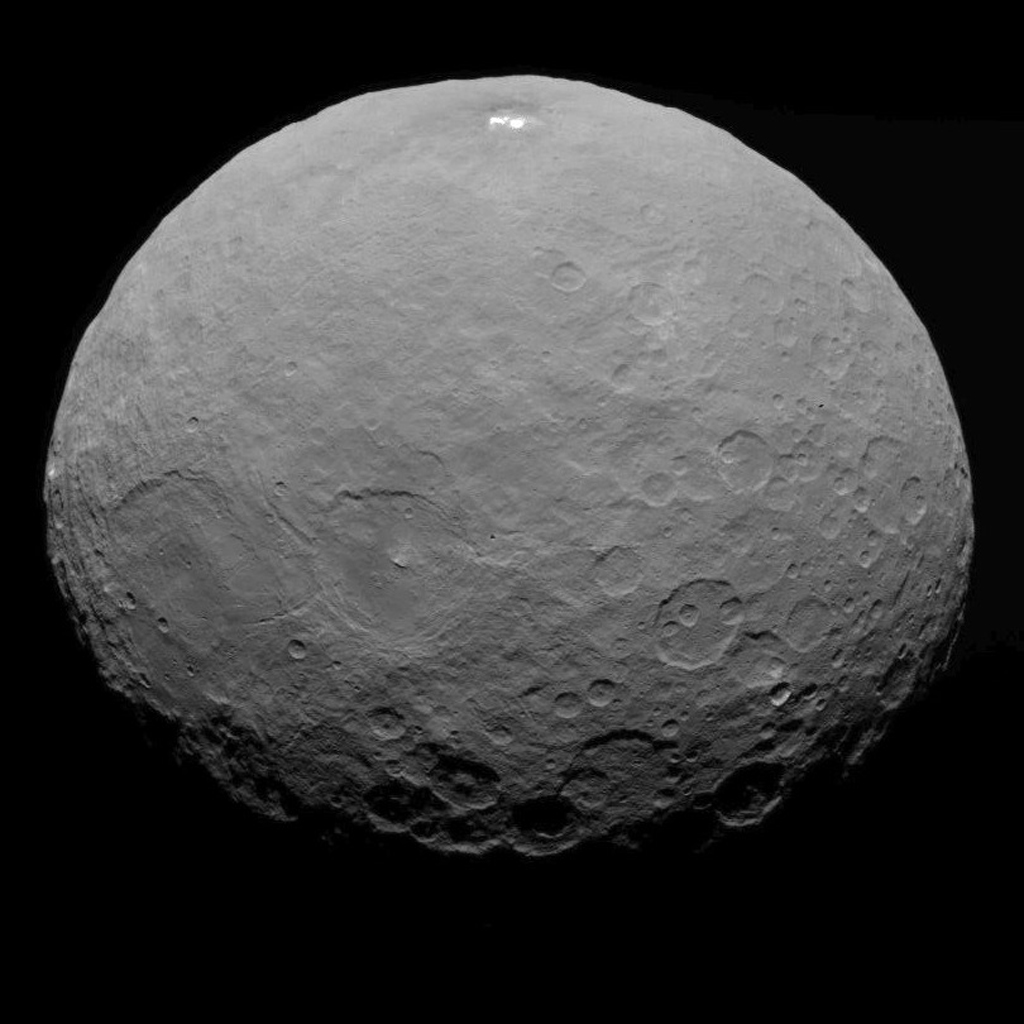
As the single-largest body in the Asteroid Belt, Ceres has long been a source of fascination to astronomers. In addition to being the only asteroid large enough to become rounded under its own gravity, it is also the only minor planet to be found within the orbit of Neptune. And with the arrival of the Dawn probe around Ceres in March of 2015, we have been treated to a steady stream of scientific finds about this protoplanet.
The latest find, which has come as something of a surprise, has to do with the composition of the planet. Contrary to what was previously suspected, new evidence shows that Ceres has large deposits of water ice near its surface. This and other evidence suggests that beneath its rocky, icy surface, Ceres has deposits of liquid water that could have played a major role in its evolution.
This evidence were presented at the 2016 American Geophysical Union meeting, which kicked off on Monday, Dec. 12th, in San Fransisco. Amid the thousands of seminars that detailed the biggest findings made during the past year in the fields of space and Earth science – which included updates from the Curiosity mission – members of the Dawn mission team shared the results of their research, which were recently published in Science.
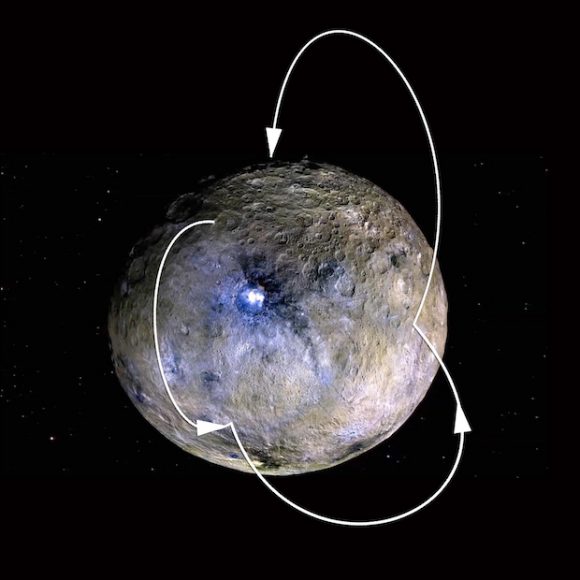
Titled “Extensive water ice within Ceres’ aqueously altered regolith: Evidence from nuclear spectroscopy“, the mission team’s study details how data gathered by Dawn’s Gamma Ray and Neutron Detector (GRaND) determined the concentrations of hydrogen, iron and potassium in Ceres crust. In so doing, it was able to place constraints on the planet’s ice content, and how the surface was likely altered by liquid water in Ceres’ interior.
In short, the GRaND instrument detected high levels of hydrogen in Ceres’ uppermost structure (10% by weight), which appeared most prominently around the mid-latitudes. These readings were consistent with broad expanses of water ice. The GRaND data also showed that rather than consisting of a solid ice layer, the ice was likely to take the form of a porous mixture of rocky materials (in which ice fills the pores).
Previously, ice was thought to only exist within certain cratered regions on Ceres, and was thought to be the result of impacts that deposited water ice over the course of Ceres’ long history. But as Thomas Prettyman – the principal investigator of Dawn’s GRaND instrument – said in a NASA press release, scientists are now rethinking this position:
“On Ceres, ice is not just localized to a few craters. It’s everywhere, and nearer to the surface with higher latitudes. These results confirm predictions made nearly three decades ago that ice can survive for billions of years just beneath the surface of Ceres. The evidence strengthens the case for the presence of near-surface water ice on other main belt asteroids.”
The concentrations of iron, potassium and carbon detected by the GRaND instrument also supports the theory that Ceres’ surface was altered by liquid water in the interior. Basically, scientists theorize that the decay of radioactive elements within Ceres created enough heat to cause the protoplanet’s structure to differentiate between a rocky interior and icy outer shell – which also allowed minerals like those observed to be deposited in the surface.
Similarly, a second study produced by researchers from the Max Planck Institute for Solar Research examined hundreds of permanently-shadowed craters located in Ceres’ northern hemisphere. According to this study, which appeared recently in Nature Astronomy, these craters are “cold traps”, where temperatures drop to less than 11o K (-163 °C; -260 °F), thus preventing all but the tiniest amounts of ice from turning into vapor and escaping.
Within ten of these craters, the researcher team found deposits of bright material, reminiscent to what Dawn spotted in the Occator Crater. And in one that was partially sunlit, Dawn’s infrared mapping spectrometer confirmed the presence of ice. This suggests that water ice is being stored in Ceres darker craters in a way that is similar to what has been observed around the polar regions of both Mercury and the Moon.
Where this water came from (i.e. whether or not it was deposited by meteors) remains something of a mystery. But regardless, it shows that water molecules on Ceres could be moving from warmer mid-latitudes to the colder, darker polar regions. This lends further weight to the theory that Ceres might have a tenuous water vapor atmosphere, which was suggested back in 2012-13 based on evidence obtained by the Herschel Space Observatory.
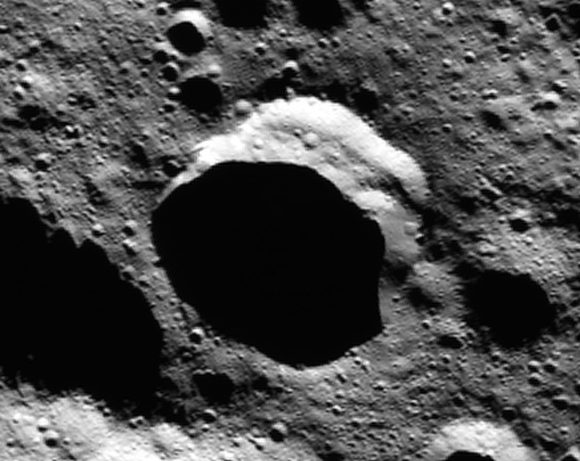
All of this adds up to Ceres being a watery and geologically active protoplanet, one which could hold clues as to how life existed billions of years ago. As Carol Raymond, deputy principal investigator of the Dawn mission, also explained in the NASA press release:
“These studies support the idea that ice separated from rock early in Ceres’ history, forming an ice-rich crustal layer, and that ice has remained near the surface over the history of the solar system. By finding bodies that were water-rich in the distant past, we can discover clues as to where life may have existed in the early solar system.”
Back in July Dawn began its extended mission phase, which consists of it conducting several more orbits of Ceres. At present, it is flying in an elliptical orbit at a distance of more than 7,200 km (4,500 mi) from the protoplanet. The spacecraft is expected to operate until 2017, remaining a perpetual satellite of Ceres until the end.

